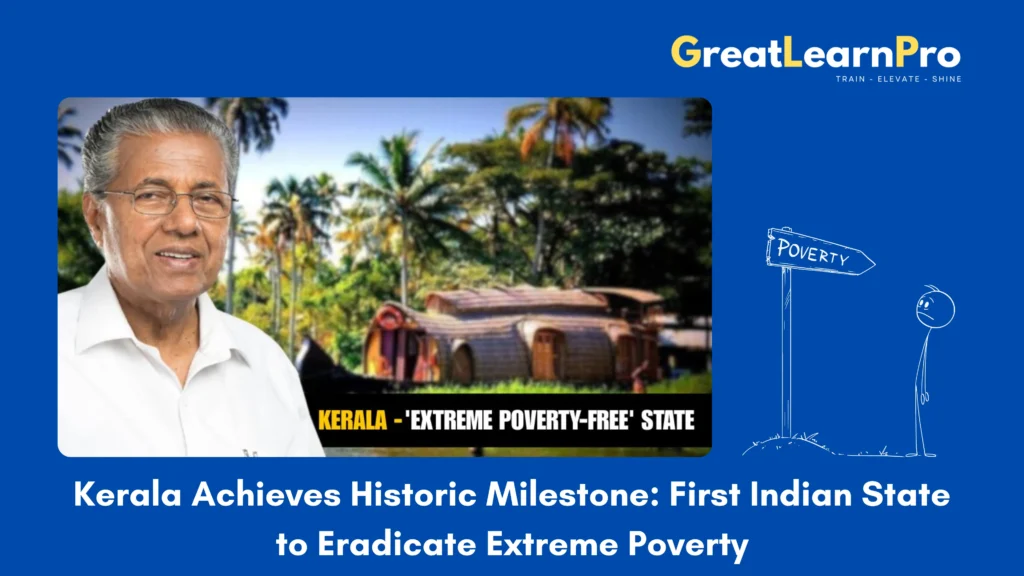Introduction
Kerala has achieved a historic milestone by becoming the first Indian state to eliminate extreme poverty. The official declaration was made on 1 November 2025, coinciding with Kerala Piravi, the state’s formation day. According to the 2023 Multidimensional Poverty Index (MPI) published by NITI Aayog, Kerala already had the lowest rate of multidimensional poverty among Indian states just 0.55% of its population. This formal declaration marks the culmination of a comprehensive effort that began in 2021 under the Extreme Poverty Eradication Programme (EPEP) launched by the state government.

Context and Significance
The achievement is not merely symbolic it represents a crucial advancement toward the United Nations Sustainable Development Goal 1, which seeks to end poverty in all its forms everywhere. In India, poverty is increasingly measured through a multidimensional approach that looks beyond income, assessing deprivations in education, health, housing, and access to essential services.
Kerala’s ability to reduce multidimensional poverty to 0.55% highlights the success of its long-standing investment in social infrastructure, public health, and education. With this milestone, Kerala has demonstrated that eradicating extreme poverty is not an abstract goal but an achievable reality when governance and grassroots participation work hand in hand.
How Kerala Achieved It
1. Clear Political Commitment
The Left Democratic Front (LDF) government made poverty eradication a top priority soon after assuming office in 2021. The Extreme Poverty Eradication Programme was launched with a vision to identify and uplift every family living in extreme deprivation.
2. Accurate Identification of Families
A massive state-wide survey was undertaken with the help of local self-governments, Kudumbashree units, ASHA and anganwadi workers. This collaborative approach identified around 64,000 families living in extreme poverty based on indicators such as food insecurity, poor health, lack of housing, and unstable income sources.
3. Tailored Micro-Plans for Each Household
Each identified household received an individualized micro-plan instead of generic welfare benefits. These micro-plans addressed specific needs such as housing repair, land allocation, medical care, skill training, and livelihood assistance.
4. Coordination Across Departments
Multiple government departments housing, health, local self-government, rural development, and social welfare worked in coordination to ensure the smooth implementation of the programme. Local bodies, panchayats, and municipalities monitored progress and ensured accountability.
5. Comprehensive Welfare Measures
Some of the tangible results include:
- Construction of nearly 4,000 new houses for the poor.
- Repair and renovation of over 5,600 homes.
- Land allotment to more than 1,300 families.
- Legal and identity documentation provided to over 20,000 individuals.
This integrated approach ensured that every family moved out of multiple layers of deprivation simultaneously.
6. Time-Bound Implementation and Monitoring
The government set a clear deadline — to make Kerala completely free of extreme poverty by November 1, 2025. Certain districts, such as Kottayam, were declared “extreme poverty free” earlier in 2025, serving as pilot models for the rest of the state.
Challenges and Criticisms
While the announcement is widely celebrated, experts have raised valid concerns that warrant attention:
- Definition of Extreme Poverty: The criteria used for identifying extreme poverty must be clearly defined and made public to ensure transparency.
- Verification and Independent Audit: Independent verification of the results is necessary to confirm that all identified families have indeed moved out of poverty.
- Sustainability: Eliminating poverty is not a one-time achievement. Without consistent monitoring and livelihood support, families may relapse into poverty.
- Residual Deprivation: Even with a 0.55% poverty rate, thousands may still remain vulnerable, especially among tribal communities and migrant populations.
- Replication Challenges: Kerala’s unique social infrastructure — high literacy rates, decentralized governance, and strong health networks — may not be easily replicated in other states.
Lessons from Kerala’s Model
- Community-Centric Approach – Empowering local bodies and community groups ensures better identification and monitoring.
- Household-Level Planning – Micro-level interventions can address the unique needs of families, preventing exclusion.
- Integrated Governance – Coordinated action among multiple departments leads to sustainable results.
- Target-Oriented Implementation – Setting clear timelines creates urgency and accountability.
- Holistic Poverty Reduction – Addressing housing, health, education, and livelihood together provides a lasting exit from deprivation.
The Road Ahead
Kerala’s challenge now is to sustain this success. Periodic re-surveys and audits will help ensure that no family slips back into poverty. The state also needs to focus on skill development, job creation, and climate resilience to protect vulnerable communities from future shocks.
Transparency in data and sharing of best practices will allow other states to learn and adapt Kerala’s model. The emphasis must shift from temporary welfare to permanent empowerment through sustainable income and social inclusion.
Conclusion
Kerala’s declaration as India’s first state to eliminate extreme poverty marks a turning point in India’s social development narrative. It showcases what can be achieved through a combination of political will, participatory governance, and focused planning.
While challenges remain, Kerala’s model provides a replicable framework for inclusive growth and poverty eradication. The milestone reminds the nation that the dream of “zero poverty” is not utopian — with the right approach, it is within reach.
Sources:
- https://timesofindia.indiatimes.com/life-style/travel/which-is-the-first-indian-state-to-eradicate-extreme poverty/amp_articleshow/125089585.cms
- https://www.deshabhimani.com/deshabhimani-english-/kerala-news/kerala-reaches-invisible-overlooked-historic-poverty-free-milestone-27098
More Current affairs: https://learnproacademy.in/updates/
